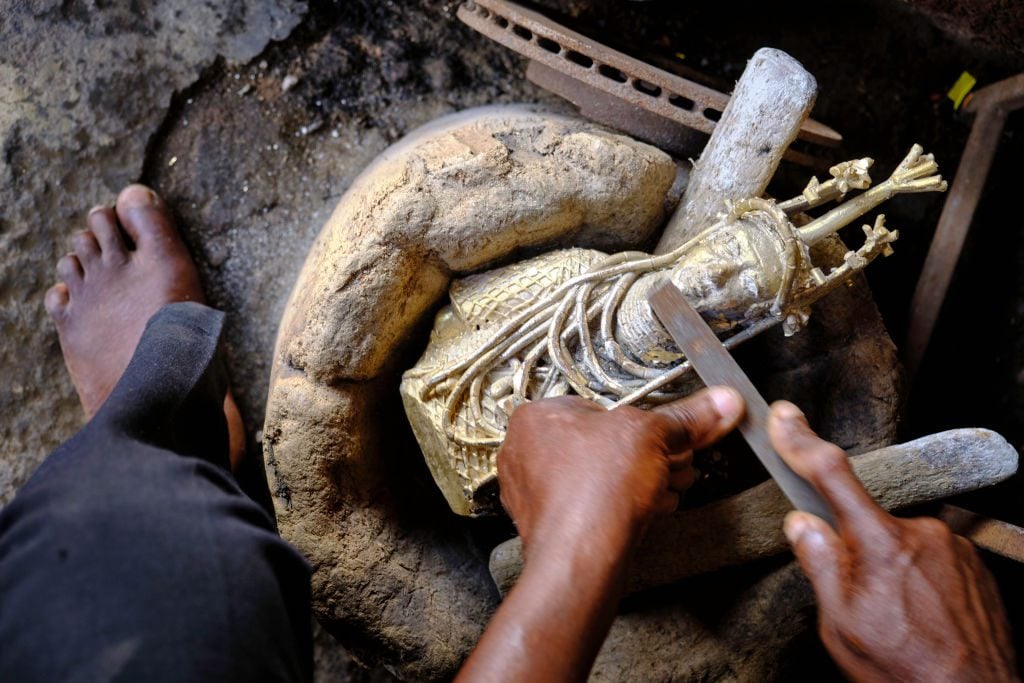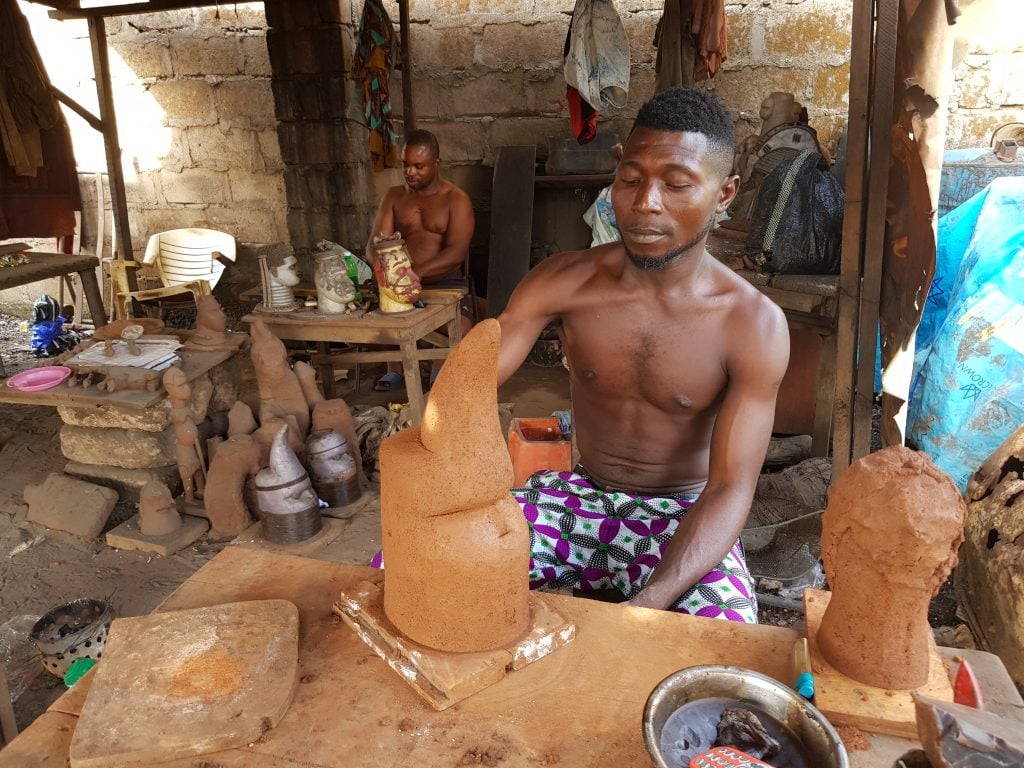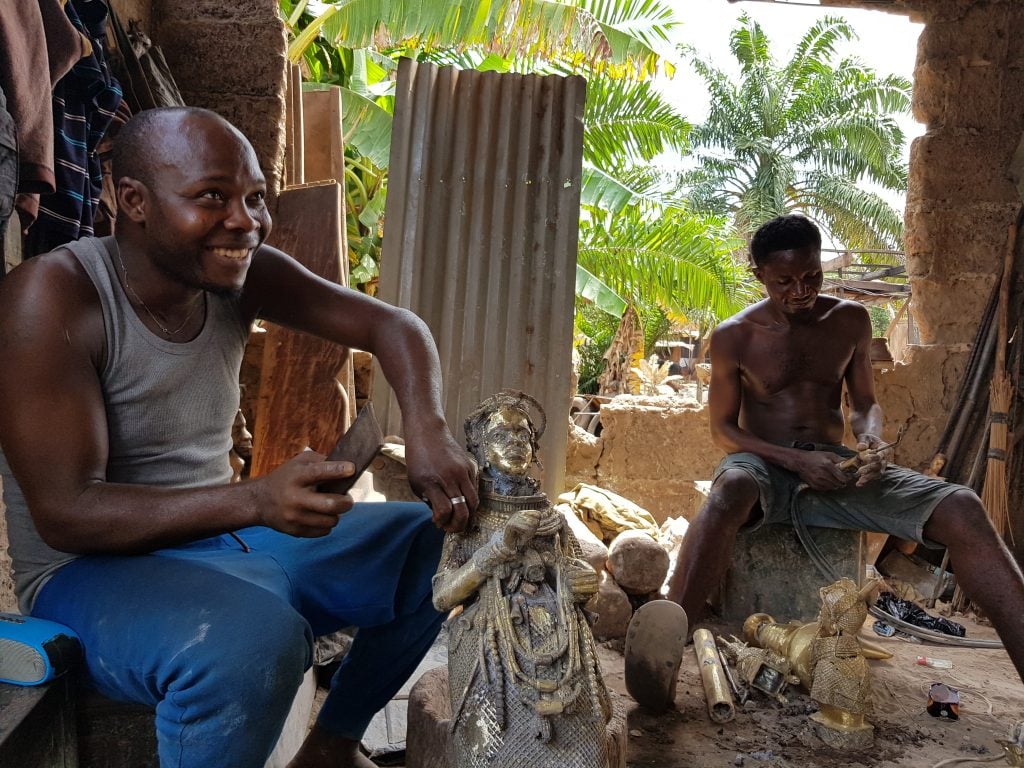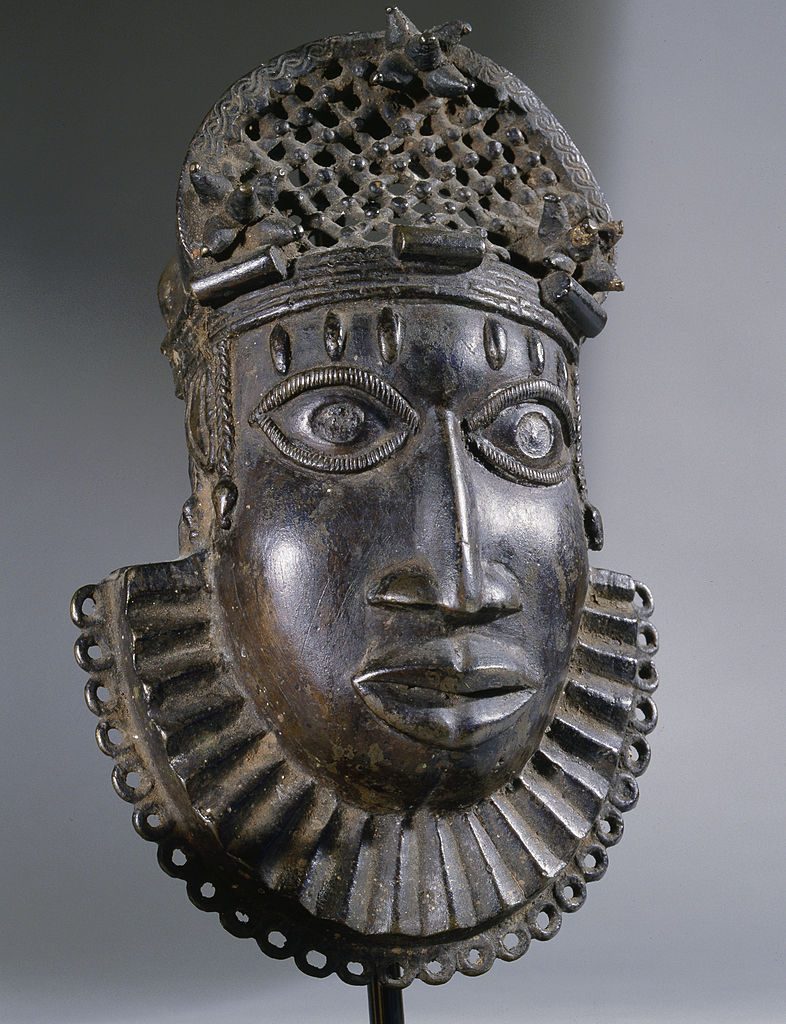Books
The Benin Bronzes Aren’t Just Ancient History. Meet the Contemporary Casters Who Are Still Making Them Today
In an excerpt from his new book, Barnaby Phillips visits contemporary casters who are still making bronzes using ancient techniques.

In an excerpt from his new book, Barnaby Phillips visits contemporary casters who are still making bronzes using ancient techniques.

Barnaby Phillips

In his new book, Loot: Britain and the Benin Bronzes, Barnaby Phillips, a journalist specializing in African affairs, looks at the past and future of the contested sculptures, thousands of which were stolen during a 19th-century punitive British raid of the Benin Royal Palace in modern-day Nigeria. In this excerpt, Phillips visits contemporary casters who are still making bronzes using ancient techniques, but largely working from images, given that their heritage is held in museums abroad.
If you walk from the Oba’s palace, it might take you five minutes to reach Igun Street. Much depends on the traffic around Benin City’s central roundabout—whether it fleetingly relents and you have the courage to plunge through the cars, buses, and motorbikes, and ignore their urgent horns. At the turning for Sokponba Road, you’ll pass a statue, erected in the 1980s. A Benin warrior, cast in dark metal and carrying a spear and shield, stands triumphant, a silhouette against the harsh bright sky. At his feet are strewn four British soldiers. Three are slumped and clutch their stomachs in agony, the fourth has collapsed and appears to be dead. The statue captures a moment of heroism from 1897, even if the invaders’ uniforms and weapons appear more Second World War than late-Victorian. Asoro, the Oba’s trusted warrior, is said to have fought valiantly at this spot, slaying the enemy until finally he too fell. From a crushing defeat, the statue seems to say, an eventual victory emerged. Benin did not die. Asoro’s battle cry—So̒kpọ̒nba̒; “Only the Oba dare pass this spot”—has been immortalized with the naming of the Sokponba Road.
Igun Street, the next turn on the left, was there long before the British marched in. You enter through a red arch inscribed with the words “Guild of Benin Bronze Casters, World Heritage Site.” The street runs ramrod straight, lined by modest single-storey clay houses. The casters and craftsmen display their wares on the front terraces; rows and rows of twice life-size brass leopards, American bald eagles, Greek and Roman gods and mermaids, monstrously long brass tusks, shiny icons of Benin history glued onto wooden or red felt backgrounds, wooden giraffes, and paintings of scantily dressed women. Christian, classical, and Benin traditions are carelessly merged together. It’s easy to be unkind about what Igun Street has become, and many are. Young artists in Benin or Lagos, and the more discerning expatriates in Lagos, dismiss most of its offerings as kitsch, “tourist” or “airport art.” One long-time American observer of Benin City likened the street to Tijuana. Even Igun Street’s claim to global recognition is dubious—when I checked the website of UNESCO, the body which awards World Heritage status, I was deflated to find no mention of it there.

The brass casters today. Igun Street, Benin City. Photo: Barnaby Phillips
The miracle of Igun Street is not what is sold at the front of its humble stores, but what happens in the workshops and studios behind. On patches of broken land, surrounded by cast-offs and piles of breeze blocks, men sit on plastic chairs and wooden benches and work on their bronze and brass casting. They are the roughly 120 members of an exclusive guild, Igun Eronmwon. They use skills learnt from their fathers, who in turn learnt from their fathers, and so on and so on, all the way back, they say, to the thirteenth century. A few of the families that make up Igun Eronmwon have moved to other parts of the city, but most remain on Igun Street, working as they’ve done for the past 800 years. Until very recently, this was an exclusively male craft; one prominent caster said that if a woman learnt the skills and then married there was a danger she would take her knowledge to her new family.
They call their technique Lost Wax. It was practiced by the ancient Greeks and Romans, and across Europe during the Middle Ages and into the Renaissance, often referred to by its French term, cire perdue. But there is nothing inherently “European” about Lost Wax. It was used in ancient Egypt, from Mesopotamia to the Indus Valley, in South-East Asia, and in ancient China. It was used by the people of Central America before the arrival of Christopher Columbus. And in Sub-Saharan Africa, Lost Wax was used on Igun Street, in Benin City, before the first white man appeared.

Using skills learnt from their forefathers – the brass casters of Benin City. Photo: Barnaby Phillips
It is a complex process that requires skill but allows for intricacy and detail. Imagine a member of Igun Eronmwon wished to make a ceremonial head of an Oba. He would begin by shaping a solid core of sandy clay with his hands, maybe using a wooden or metal file to refine it. Today, as in the past, the casters get their clay from the banks of the Ikpoba River, which runs through the north of Benin City. Once he has shaped the core into a rough form, he covers it in a thin layer of beeswax. Now he introduces detail, not just in sculpting facial features, but also, perhaps, by adding extra wax threads to make the beads of a headdress or the coral bead coat an Oba might wear. The wax must be soft enough to allow such detail, but hard enough to keep its shape. Next, the caster covers his wax model in finely grained clay. He is trying to ensure this outer covering takes a faithful impression of the wax beneath it. Then he adds a layer of heavier clay to the outside, while ensuring there is a small furrow through which the wax can escape. He dries the piece in the sun, and then bakes it in charcoal embers, until it reaches such a heat that he can pour away the melted wax.
Now the critical moment; the caster takes molten metal—bronze or brass—from a furnace and pours it into the mould left behind by the departed wax, filling every hollow and tiny crevice. If he has failed to heat the piece sufficiently, it may crack when he pours in the liquid metal, and he must throw everything away. Often the caster must wait for a tense half hour, as the piece cools. He may seek the blessing of Ogun, the patron divinity of craftsmen, spilling spirit on a shrine. Then he begins to prise away the clay exterior, in the hope of finding a perfect metal cast underneath.

A hip pendant of the type worn as part of the ceremonial dress of Benin chiefs, Nigeria. Edo. 17th century. Benin City. (Photo by Werner Forman/Universal Images Group/Getty Images)
Some things have changed. Traditionally, the members of Igun Eronmwon used bellows and human sweat as they toiled to heat their furnaces, whereas nowadays many use compressed air from air-conditioner motors. The supply of metal ebbs and flows. In the late 1960s, as the Biafran War raged to the east, Benin City’s casters revelled in a windfall of spent bullet cartridges. Today, old engine parts are a staple source of raw material. Enterprising women deliver bags of discarded taps, valves, and pipes. Dealers bring ship propellers on their trucks, salvaged from the rusty hulks of the Niger Delta. For hundreds of years, the Igun Eronmwon guild worked for its one and only patron, the Oba. He provided security—slaves, money and other gifts—but little freedom. Now, members of the guild can sell their work to passing tourists, or hope that a hotel or bank will commission a monumental statue for a foyer, or that a wealthy man is looking for a metal design for his mansion gates. Or perhaps an evangelical pastor would like a giant pair of praying hands to decorate the exterior of his church.
Other things are much as they were. The successful caster has always been more than an artist; he must also be a master of pottery and metallurgy. The Lost Wax method is still laborious and unforgiving of shoddy shortcuts, poor raw material, and bad craftsmanship. The caster can make only one piece from each wax mould. There are no replicas, no way to run off a few extra copies. Each piece, masterpiece or mediocre, is unique. These days, many people in Benin City and beyond complain that there is too much of the latter, not enough of the former. They criticize casters for being stuck in the past, unimaginatively churning out lacklustre imitations of their ancestors’ work. A Lagos art dealer, his home a temple of refined taste in traditional and contemporary Nigerian sculpture, told me how saddened he was that members of the Igun Eronmwon guild spend all their efforts “to replicate rather than using those skills to represent what is happening in their own time.” But this is hardly surprising; Benin City’s casters, like so many in Nigeria, are struggling to get by. They need food on their table before they can think of experimentation and creativity.

A plaque which decorated the palace of the Obas, Benin warriors are depicted in battle. Nigeria. Edo. Probably late 17th century. Benin City. (Photo by Werner Forman/Universal Images Group/Getty Images)
The Omodamwen family are pillars of the Igun Eronmwon guild. Phil Omodamwen, the head of his foundry, says his family have been casting for 500 years. An impressive but self-effacing man in his late 40s, Phil has good connections with wealthy expatriates in Lagos and international art dealers. Many of his biggest pieces are commissioned from overseas. “We have standards, the Omodamwen family,” he says. “We’re very careful with the materials we have.” Phil has travelled to the United States, Belgium, and France to exhibit his work. He has two children in private universities—”with the help of God.” He employs 50 people and has a gas-fired foundry to handle larger orders. And yet he says the future is precarious. Phil used to sell his work for good prices to foreign workers in Nigeria’s oil capital, Port Harcourt, but kidnappings and insecurity in the Niger Delta have made journeys to that city increasingly dangerous. His own children are not interested in becoming casters, and he is not surprised that young people want to make their fortunes in other ways. “I have cousins who left. They went across the Sahara Desert. They tried to cross the rough sea. Not all of them made it. Some are in Europe right now, maybe seeking asylum. The work here is very capital intensive. If you don’t have good customers, you won’t be encouraged to do more.”
The members of Igun Eronmwon have no formal training. They are not taught to sketch, they are not draughtsmen. They learn by watching and listening to their fathers and elders, and studying photographs of the celebrated pieces of Benin art. But just as they are criticized for rigidly adhering to traditional designs, they are also criticized for failing to attain the high standards of the past. Where, some have asked, is the sensuous subtlety of their predecessors? But this begs the question of where inspiration should come from. Today’s casters can see only a small proportion of the old art, and rely on magazine and internet photographs to study their ancestors’ greatest works. The canon of Benin’s art, the encyclopaedia of its civilisation, was stolen, and is scattered across the globe.
Loot: Britain and the Benin Bronzes by Barnaby Phillips was published this May by Oneworld Publications.